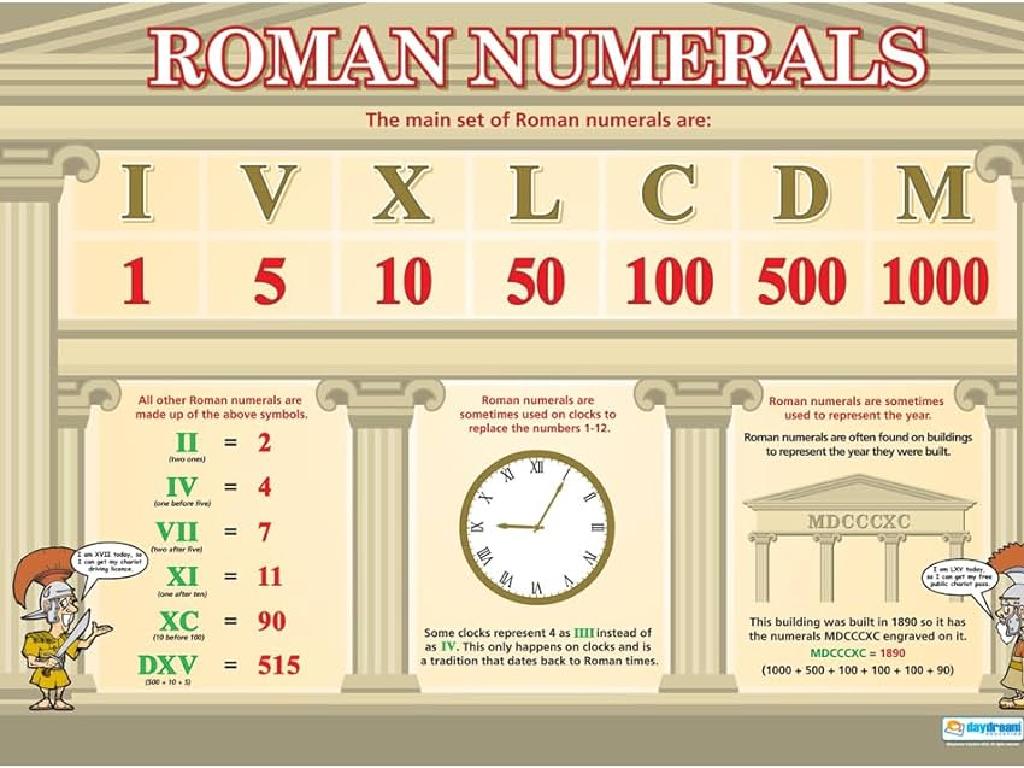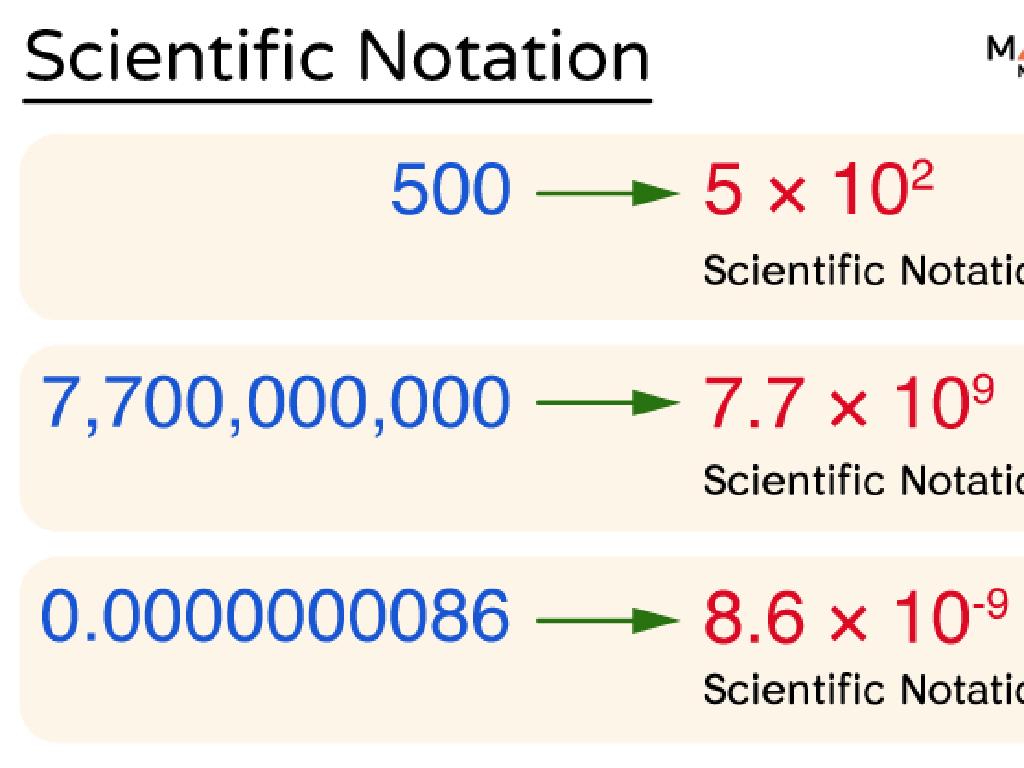Add And Subtract Mixed Numbers With Unlike Denominators: Without Regrouping
Subject: Math
Grade: Fifth grade
Topic: Add And Subtract Mixed Numbers
Please LOG IN to download the presentation. Access is available to registered users only.
View More Content
Introduction to Mixed Numbers
– What are mixed numbers?
– A number made up of a whole number and a fraction, like 2 1/3.
– Parts of mixed numbers
– Whole number part: 2, Fraction part: 1/3 in 2 1/3.
– Real-life mixed number examples
– Using mixed numbers when cooking, e.g., 1 1/2 cups of sugar.
– Adding & subtracting without regrouping
|
Begin by explaining that mixed numbers are a combination of a whole number and a fraction, which helps in measuring quantities that aren’t whole. Show how to identify and separate the whole number and fraction parts of a mixed number. Provide relatable examples such as cooking measurements or distances to illustrate the concept. Then, introduce the concept of adding and subtracting mixed numbers with unlike denominators without regrouping, ensuring to clarify that the focus is on understanding the concept rather than performing complex calculations at this stage.
Understanding Unlike Denominators
– Denominators: bottom numbers in fractions
– ‘Unlike’ denominators: different bottoms
– When fractions have different denominators, they are ‘unlike’.
– Challenge of adding/subtracting
– Without the same denominators, fractions can’t be added or subtracted directly.
– Strategies to overcome challenges
– Find a common denominator or convert to improper fractions to solve.
|
This slide introduces the concept of denominators and sets the stage for understanding the complexity of adding and subtracting mixed numbers with unlike denominators. Denominators are the bottom numbers in fractions that indicate into how many parts a whole is divided. When fractions have different denominators, they are considered ‘unlike’, and this poses a challenge for direct addition or subtraction. To address this, students will learn strategies such as finding a common denominator or converting mixed numbers to improper fractions to facilitate the calculation. Emphasize the importance of these foundational skills as they are crucial for solving more complex math problems involving fractions.
Visualizing Mixed Numbers with Pie Charts
– Pie charts show mixed numbers
– Each pie chart slice represents a part of a whole number
– Visualize adding & subtracting
– Combine or remove slices to see the result
– Examples with pie charts
– See how 2 1/3 + 1 2/3 becomes a whole pie plus slices
– Practice without regrouping
|
This slide is aimed at helping students understand the concept of mixed numbers and how to add and subtract them using visual aids like pie charts. By representing mixed numbers as pie charts, students can easily see how each part contributes to the whole. When adding or subtracting, they can visually combine or take away slices of the pie to find the answer. Provide examples using pie charts to show the process step by step. Emphasize that we are not regrouping in this lesson, so all pie charts should have the same number of slices to represent the whole. Encourage students to draw their own pie charts for practice.
Adding Mixed Numbers with Unlike Denominators
– Steps to add mixed numbers
– Find common denominator, convert, then add
– Example: 2 1/4 + 3 1/3
– Convert 2 1/4 and 3 1/3 to have common denominators
– Finding common denominators
– Common denominator for 1/4 and 1/3 is 12
– Adding whole numbers and fractions separately
– Add whole numbers, then add fractions
|
Begin by explaining the steps to add mixed numbers with unlike denominators, emphasizing the importance of finding a common denominator before adding. Use the example 2 1/4 + 3 1/3 to illustrate the process. Show how to convert each mixed number so that the fractional parts have the same denominator, in this case, 12. Once the denominators are the same, guide students to add the whole numbers together and then the fractions. Remind them that the fractions should be added separately from the whole numbers and combined at the end for the final sum. Encourage students to practice this method with various examples to build their confidence.
Subtracting Mixed Numbers Without Regrouping
– Steps to subtract mixed numbers
– Find a common denominator, subtract fractions, then subtract wholes
– Example: 5 2/5 – 2 1/4
– Convert to improper fractions: 27/5 – 9/4, find common denominator: 20, subtract: 108/20 – 45/20
– Understand borrowing concept
– Sometimes you need to ‘borrow’ from the whole number to subtract the fractions
– No borrowing needed here
|
This slide introduces the process of subtracting mixed numbers with unlike denominators without the need for regrouping. Start by explaining the steps to find a common denominator and then subtract the fractions before dealing with the whole numbers. Use the example 5 2/5 – 2 1/4 to illustrate the process, converting mixed numbers to improper fractions and finding a common denominator. Emphasize that in this example, borrowing from the whole number isn’t necessary as the fractional part of the minuend is larger than the subtrahend. However, explain the concept of borrowing for cases where it is required. Encourage students to practice with additional examples and ensure they understand when and why borrowing might be needed.
Mixed Numbers: Practice Makes Perfect
– Solve mixed number problems together
– Add and subtract mixed numbers with different denominators, e.g., 2 1/4 + 3 2/5
– Explain your problem-solving steps
– Share how you figured out the answer. Did you find a common denominator first?
– Address misconceptions promptly
– If you make a mistake, that’s okay! Let’s find and fix it together.
– Practice with different problem sets
|
This slide is designed for a collaborative classroom activity where students work on adding and subtracting mixed numbers with unlike denominators. The teacher should guide the class through a series of problems, encouraging students to verbalize their thought process as they solve each problem. This will help in identifying and correcting any misconceptions immediately. It’s important to foster a supportive environment where mistakes are seen as learning opportunities. The teacher should prepare several sets of problems with varying levels of difficulty to ensure that all students can participate and practice effectively.
Class Activity: Mixed Numbers Challenge
– Create your own mixed number problems
– Swap problems with a classmate
– Solve your partner’s problem
– Discuss solutions and strategies
– Share how you solved the problem and the strategy you used
|
This activity is designed to foster collaboration and peer learning among students. Each student will create their own set of problems involving the addition and subtraction of mixed numbers with unlike denominators, without regrouping. After creating these problems, they will exchange their problems with a partner and work on solving them. This will not only help students practice their problem-solving skills but also allow them to see different types of problems created by their peers. Once everyone has solved the problems, there will be a class discussion where students will explain the strategies they used and the solutions they found. The teacher should circulate during the activity to provide guidance and ensure that the problems created are appropriate for the concept being practiced. Possible activities for different students could include creating word problems, using visual aids like pie charts, or finding real-life scenarios where mixed number operations are applicable.
Conclusion & Homework: Mastering Mixed Numbers
– Recap: Adding & subtracting mixed numbers
– Remember to find a common denominator and convert to improper fractions.
– Practice and patience are key
– Learning math is like learning an instrument, it takes time!
– Homework: Mixed numbers worksheet
– Complete the worksheet to become a mixed number pro.
– Keep practicing at home!
|
As we wrap up today’s lesson, remind students of the steps to add and subtract mixed numbers with unlike denominators, emphasizing the importance of finding a common denominator and converting to improper fractions before performing operations. Stress the value of practice and patience in mastering new math skills, comparing it to learning a musical instrument or a new sport. Assign a worksheet for homework to reinforce today’s concepts and encourage students to continue practicing these skills at home. The worksheet should include a variety of problems to cater to different skill levels and ensure comprehensive practice.






